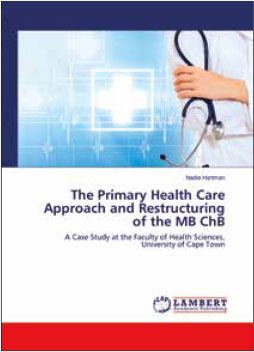Services on Demand
Article
Indicators
Related links
-
 Cited by Google
Cited by Google -
 Similars in Google
Similars in Google
Share
SAMJ: South African Medical Journal
On-line version ISSN 2078-5135
Print version ISSN 0256-9574
SAMJ, S. Afr. med. j. vol.105 n.1 Pretoria Jan. 2015
BOOK REVIEWS
The Primary Health Care Approach and Restructuring of the MB ChB: A Case Study of the Faculty of Health Sciences, University of Cape Town

By Nadia Hartman. Lambert Academic Publishing, 2014. ISBN: 978-3-8484-4941-5. info@lap-publishing.com
In the late 1990s, the Faculty of Health Sciences (FHS) at the University of Cape Town caught the 'wave' of educational curriculum reform, responding to several imperatives. The context was post-1994 democratic South Africa (SA), and the government's efforts to establish a primary healthcare (PHC)-led national health system requiring (since health professionals would receive service-based training within such a system) congruent curriculum reform.
The Primary Health Care Approach and Restructuring of the MB ChB is the distillation of Dr Nadia Hartman's research into the extent to which alignment was achieved between the PHC philosophy, espousing a biopsychosocial approach to patients, and the reformed MB ChB curriculum that was implemented in 2002. Dr Hartman is an educational scientist - my term for the colleagues usually termed educationists -and founding director of the Educational Development Unit in UCT's FHS, which became the 'engine room' of educational reform as curriculum restructuring began. Given the strength of her case history, and the scientific method deployed, my term is apt and deserved.
At UCT's FHS, the dominant 'habitus' (Hartman's word) was the traditional biomedical (diagnose and treat) approach to illness, in the context of an increasing burden of disease, shrinking health and tertiary educational budgets and reliance on secondary and tertiary hospital-based service learning and 'apprenticeship' training. All conspired to bring about an imperfect, as yet unrealised, biopsychosocial habitus that is the ideal of the PHC holistic/comprehensive approach.
Dr Hartman's case study meticulously records the processes as they evolved towards realisation of a 'blueprint', developed in the opening phases of development of the reformed curriculum that was launched in 2002.
In the words, echoed by the Health Professions Council of South Africa, of an external report: 'it would appear that much of the excellent theoretical input and emphasis on the biopsychosocial approach in a PHC context in the first 3 years [of the curriculum] is undermined by the traditional biomedical approach of the latter years.'
The penultimate chapter (chapter 6) is a rich summary of the processes, which took place over two years, that put 'flesh' on the 'bones' of the curriculum blueprint, and of the shifts in control of the educational strategies from heads of departments to within the Education Development Unit.
The successes are highlighted: the multi-disciplinary and multiprofessional faculty foundation courses that embed, and are strongly aligned with, the PHC approach; and the basic sciences courses (running over 2½ years), characterised by a (UCT-specific) hybrid of problem-based learning applied to commonly occurring illnesses that are representative of SA's disease burden, along with clinical skills training that begins in year 2 and continues through year 3.
So also are the failures, the basis of which is multifactorial but the consequences of which are clinical. Years 4 - 6, characterised by biomedical, silo-based disciplinary teaching and experiential learning in secondary and tertiary hospital settings, are unlikely to 'fit' a graduate for 'real-world' SA practice in (sometimes) unsupervised internships and community service - and encourage subspecialist rather than general practice/ general specialty career choices after graduation.
In the words of one of the curriculum design team conveners: 'we [referring to UCT's FHS] started a curriculum change process to produce generalists and did not invest in strengthening our small Primary Care Department'. Equally sobering, all these years later, is to hear another state: 'there is ignorance around the Department of Health's policy document on health systems transformation (underpinned by the PHC approach) and the HPCSA's 1997 Training Guidelines (that mandate the PHC educational approach) ... the MB ChB has never been subject to a major revision, so the tendency to specialise has been unchecked and it is a foreign concept that their practice could be guided by anyone other than themselves ... autonomous behavior that is (now) being challenged by the HPCSA Accreditation process'.
In the context, the Guest Editorial that opens this issue of SAMJ[1] deserves noting.
Hartman's book will interest those who are (medical) educationists, and those medical colleagues who choose medical education as a subspecialty interest.
Janet Seggie
Editor
janet.seggie@hmpg.co.za
1. Benatar S. The humanistic side of medical education. S Afr Med J 2015;105(1):3. [http://dx.doi.org/10.7196/SAMJ.9043] [ Links ]














